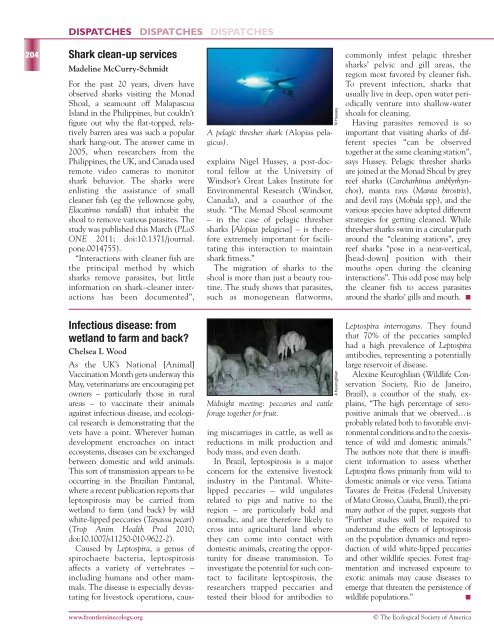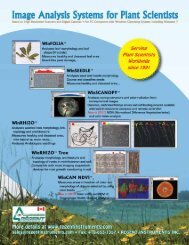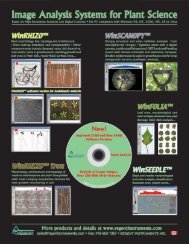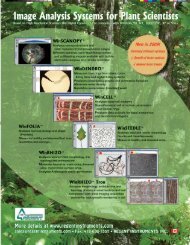Dispatches - Frontiers in Ecology and the Environment
Dispatches - Frontiers in Ecology and the Environment
Dispatches - Frontiers in Ecology and the Environment
You also want an ePaper? Increase the reach of your titles
YUMPU automatically turns print PDFs into web optimized ePapers that Google loves.
DISPATCHES DISPATCHES<br />
DISPATCHES<br />
204<br />
Shark clean-up services<br />
Madel<strong>in</strong>e McCurry-Schmidt<br />
For <strong>the</strong> past 20 years, divers have<br />
observed sharks visit<strong>in</strong>g <strong>the</strong> Monad<br />
Shoal, a seamount off Malapascua<br />
Isl<strong>and</strong> <strong>in</strong> <strong>the</strong> Philipp<strong>in</strong>es, but couldn’t<br />
figure out why <strong>the</strong> flat-topped, relatively<br />
barren area was such a popular<br />
shark hang-out. The answer came <strong>in</strong><br />
2005, when researchers from <strong>the</strong><br />
Philipp<strong>in</strong>es, <strong>the</strong> UK, <strong>and</strong> Canada used<br />
remote video cameras to monitor<br />
shark behavior. The sharks were<br />
enlist<strong>in</strong>g <strong>the</strong> assistance of small<br />
cleaner fish (eg <strong>the</strong> yellownose goby,<br />
Elacat<strong>in</strong>us r<strong>and</strong>alli) that <strong>in</strong>habit <strong>the</strong><br />
shoal to remove various parasites. The<br />
study was published this March (PLoS<br />
ONE 2011; doi:10.1371/journal.<br />
pone.0014755).<br />
“Interactions with cleaner fish are<br />
<strong>the</strong> pr<strong>in</strong>cipal method by which<br />
sharks remove parasites, but little<br />
<strong>in</strong>formation on shark–cleaner <strong>in</strong>teractions<br />
has been documented”,<br />
A pelagic thresher shark (Alopias pelagicus).<br />
expla<strong>in</strong>s Nigel Hussey, a post-doctoral<br />
fellow at <strong>the</strong> University of<br />
W<strong>in</strong>dsor’s Great Lakes Institute for<br />
<strong>Environment</strong>al Research (W<strong>in</strong>dsor,<br />
Canada), <strong>and</strong> a coauthor of <strong>the</strong><br />
study. “The Monad Shoal seamount<br />
– <strong>in</strong> <strong>the</strong> case of pelagic thresher<br />
sharks [Alopias pelagicus] – is <strong>the</strong>refore<br />
extremely important for facilitat<strong>in</strong>g<br />
this <strong>in</strong>teraction to ma<strong>in</strong>ta<strong>in</strong><br />
shark fitness.”<br />
The migration of sharks to <strong>the</strong><br />
shoal is more than just a beauty rout<strong>in</strong>e.<br />
The study shows that parasites,<br />
such as monogenean flatworms,<br />
N Hussey<br />
commonly <strong>in</strong>fest pelagic thresher<br />
sharks’ pelvic <strong>and</strong> gill areas, <strong>the</strong><br />
region most favored by cleaner fish.<br />
To prevent <strong>in</strong>fection, sharks that<br />
usually live <strong>in</strong> deep, open water periodically<br />
venture <strong>in</strong>to shallow-water<br />
shoals for clean<strong>in</strong>g.<br />
Hav<strong>in</strong>g parasites removed is so<br />
important that visit<strong>in</strong>g sharks of different<br />
species “can be observed<br />
toge<strong>the</strong>r at <strong>the</strong> same clean<strong>in</strong>g station”,<br />
says Hussey. Pelagic thresher sharks<br />
are jo<strong>in</strong>ed at <strong>the</strong> Monad Shoal by grey<br />
reef sharks (Carcharh<strong>in</strong>us amblyrhynchos),<br />
manta rays (Manta birostris),<br />
<strong>and</strong> devil rays (Mobula spp), <strong>and</strong> <strong>the</strong><br />
various species have adopted different<br />
strategies for gett<strong>in</strong>g cleaned. While<br />
thresher sharks swim <strong>in</strong> a circular path<br />
around <strong>the</strong> “clean<strong>in</strong>g stations”, grey<br />
reef sharks “pose <strong>in</strong> a near-vertical,<br />
[head-down] position with <strong>the</strong>ir<br />
mouths open dur<strong>in</strong>g <strong>the</strong> clean<strong>in</strong>g<br />
<strong>in</strong>teractions”. This odd pose may help<br />
<strong>the</strong> cleaner fish to access parasites<br />
around <strong>the</strong> sharks’ gills <strong>and</strong> mouth. n<br />
Infectious disease: from<br />
wetl<strong>and</strong> to farm <strong>and</strong> back<br />
Chelsea L Wood<br />
Midnight meet<strong>in</strong>g: peccaries <strong>and</strong> cattle<br />
forage toge<strong>the</strong>r for fruit.<br />
As <strong>the</strong> UK’s National [Animal]<br />
Vacc<strong>in</strong>ation Month gets underway this<br />
May, veter<strong>in</strong>arians are encourag<strong>in</strong>g pet<br />
owners – particularly those <strong>in</strong> rural<br />
areas – to vacc<strong>in</strong>ate <strong>the</strong>ir animals<br />
aga<strong>in</strong>st <strong>in</strong>fectious disease, <strong>and</strong> ecological<br />
research is demonstrat<strong>in</strong>g that <strong>the</strong><br />
vets have a po<strong>in</strong>t. Wherever human<br />
development encroaches on <strong>in</strong>tact<br />
ecosystems, diseases can be exchanged<br />
between domestic <strong>and</strong> wild animals.<br />
This sort of transmission appears to be<br />
occurr<strong>in</strong>g <strong>in</strong> <strong>the</strong> Brazilian Pantanal,<br />
where a recent publication reports that<br />
leptospirosis may be carried from<br />
wetl<strong>and</strong> to farm (<strong>and</strong> back) by wild<br />
white-lipped peccaries (Tayassu pecari)<br />
(Trop Anim Health Prod 2010;<br />
doi:10.1007/s11250-010-9622-2).<br />
Caused by Leptospira, a genus of<br />
spirochaete bacteria, leptospirosis<br />
affects a variety of vertebrates –<br />
<strong>in</strong>clud<strong>in</strong>g humans <strong>and</strong> o<strong>the</strong>r mammals.<br />
The disease is especially devastat<strong>in</strong>g<br />
for livestock operations, caus<strong>in</strong>g<br />
miscarriages <strong>in</strong> cattle, as well as<br />
reductions <strong>in</strong> milk production <strong>and</strong><br />
body mass, <strong>and</strong> even death.<br />
In Brazil, leptospirosis is a major<br />
concern for <strong>the</strong> extensive livestock<br />
<strong>in</strong>dustry <strong>in</strong> <strong>the</strong> Pantanal. Whitelipped<br />
peccaries – wild ungulates<br />
related to pigs <strong>and</strong> native to <strong>the</strong><br />
region – are particularly bold <strong>and</strong><br />
nomadic, <strong>and</strong> are <strong>the</strong>refore likely to<br />
cross <strong>in</strong>to agricultural l<strong>and</strong> where<br />
<strong>the</strong>y can come <strong>in</strong>to contact with<br />
domestic animals, creat<strong>in</strong>g <strong>the</strong> opportunity<br />
for disease transmission. To<br />
<strong>in</strong>vestigate <strong>the</strong> potential for such contact<br />
to facilitate leptospirosis, <strong>the</strong><br />
researchers trapped peccaries <strong>and</strong><br />
tested <strong>the</strong>ir blood for antibodies to<br />
A Keuroghlian<br />
Leptospira <strong>in</strong>terrogans. They found<br />
that 70% of <strong>the</strong> peccaries sampled<br />
had a high prevalence of Leptospira<br />
antibodies, represent<strong>in</strong>g a potentially<br />
large reservoir of disease.<br />
Alex<strong>in</strong>e Keuroghlian (Wildlife Conservation<br />
Society, Rio de Janeiro,<br />
Brazil), a coauthor of <strong>the</strong> study, expla<strong>in</strong>s,<br />
“The high percentage of seropositive<br />
animals that we observed…is<br />
probably related both to favorable environmental<br />
conditions <strong>and</strong> to <strong>the</strong> coexistence<br />
of wild <strong>and</strong> domestic animals.”<br />
The authors note that <strong>the</strong>re is <strong>in</strong>sufficient<br />
<strong>in</strong>formation to assess whe<strong>the</strong>r<br />
Leptospira flows primarily from wild to<br />
domestic animals or vice versa. Tatiana<br />
Tavares de Freitas (Federal University<br />
of Mato Grosso, Cuiaba, Brazil), <strong>the</strong> primary<br />
author of <strong>the</strong> paper, suggests that<br />
“Fur<strong>the</strong>r studies will be required to<br />
underst<strong>and</strong> <strong>the</strong> effects of leptospirosis<br />
on <strong>the</strong> population dynamics <strong>and</strong> reproduction<br />
of wild white-lipped peccaries<br />
<strong>and</strong> o<strong>the</strong>r wildlife species. Forest fragmentation<br />
<strong>and</strong> <strong>in</strong>creased exposure to<br />
exotic animals may cause diseases to<br />
emerge that threaten <strong>the</strong> persistence of<br />
wildlife populations.”<br />
n<br />
www.frontiers<strong>in</strong>ecology.org<br />
© The Ecological Society of America









